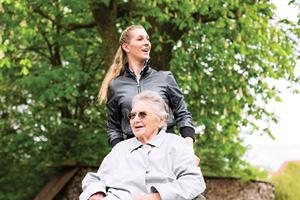How reporting can improve safety

Serious safety events continue despite the best of intentions by highly-educated and well-trained professionals. In December 2017, a woman in California brought suit against Shasta Regional Medical Center, alleging forceps were left in her abdomen after surgery.1 Preventable medical errors persist as the number three killer in the U.S. — third only to heart disease and cancer.2 According to the World Health Organization there is a one in a million chance of a traveler being harmed while in an aircraft — yet a one in 300 chance of being harmed in healthcare.3
Everyone makes mistakes
Humans are fallible, errors will occur. However, processes and systems need to be designed to prevent or detect these prior to an error causing harm.4 But, systems too can fail. When systems fail they are known as latent errors. Active errors are those that occur at the sharp end of the process — a nurse, for example, giving the wrong medication, or surgical staff leaving an instrument behind. When we hear about a wrong medication being given to a patient, or a fall while walking with a caregiver, we quite frequently decide it is because someone did something wrong. Historically in healthcare when these types of events happen we have played the blame game. Immediate termination or suspension shows action and provides an easy answer. This is extremely short sighted and does nothing to prevent the event from reoccurring, which it does quite often. When that type of response does occur, it has repercussions beyond the event and sets the stage for even more errors and harm to occur.
Avoiding the blame game
Reporting of errors as well as near misses are very important functions in healthcare organizations. However, the ease of reporting as well as what happens with that information is also critical. Staff needs to know that they are free to report without fear of retribution. This is often easier said than done; but it is imperative that management stand firm on this concept and have zero tolerance for any type of retributive behavior from anyone. Additionally, follow-up and corrective actions implemented after the report need to occur in a timely fashion. In other words the loop needs to be closed.
Reliance on just one system of error reporting to alert an organization is not wise. In addition to having a robust occurrence reporting system, additional processes should be put in place. Consideration should be given to developing triggers or metrics to indicate a potential problem, and caregivers should be encouraged for feedback regarding patient safety — some of the best information about what is actually occurring in an organization comes from front line staff. Anonymous safety surveys can also be an important tool to highlight safety concerns before an incident occurs.
The Swiss cheese model
Systems analysis pioneered by British psychologist James Reason reveals that catastrophic safety failures are almost never caused by isolated errors committed by individuals. Instead, Reason states, they are a result of a multiple of smaller errors in an environment with serious system flaws.
The "Swiss cheese model", introduced by Reason illustrates the concept that the cheese is layers of protection, but with holes representing system flaws. When the holes line up, an error occurs.5.
Why report:
- To identify early and resolve events with the potential to cause harm.
- To provide measures to evaluate care and reduce hazards that can lead to harm.
- To provide optimal patient care.
What to report:
- Any event that is not within normal operations or within the expected course of care for a patient. These events are not expected in the normal course of a patient's illness or course of treatment. This is meant to be broad in an effort to capture events that may cause harm and therefore prevent their occurrence/reoccurrence.
- Incidents which may involve patients, staff, family members, visitors or any other individual affiliated with the healthcare entity.
Who can report events?
- Anyone in the healthcare organization should be able to complete a report. To encourage the completion of occurrence reporting there should be a non-punitive culture of safety throughout the organization.
Examples of events to report:
- A fall or an event where the patient is found on the floor and that was not the intended placement.
- Events involving medications. Examples can include handing patient the wrong pill box, transporting patients to appointments without current medication lists, or not updating medication lists after physician or urgent care visits.
- Failure or delay in providing care. Missed shifts without coverage.
- Disruptive conduct from anyone such as a patient, family member, visitor or another employee.
- Failure to document events that result in or have potential to harm.
- Equipment failure or injury that occurs while equipment is in use. Can include collapsing walker, Hoyer lift that breaks, or bed that malfunctions.
- Damage or alleged theft of property.
- Notification of police or fire.
- Patient or family threatens to sue.
- Unexpected death or suicide.
- Near misses — events that did not happen because they were caught prior to occurring.
- The use of a "nanny/granny cam."
- Any accusation made by a patient or family member.
How to report:
- Write only the facts. This should be done clearly, without providing opinions or conclusions.
- The report of the occurrence should occur as close to the actual event or within 24 hours of event.
- The medical record should contain information on the facts surrounding the event. It should not include a statement regarding the completion of an occurrence report.
Should the unexpected occur, it is crucial to have the right insurance protection. The Hanover offers tailored coverages that address the unique risks faced by healthcare providers and facilities. In addition our risk solutions team provide an array of tools and resources to help you minimize risk and create a culture of safety.
References
- Arthur, Damon. Record Searchlight Part of the USA Today Network. Susanville woman says forceps left in her after surgery at Shasta Regional Medical Center. Published Dec. 27, 2017
- McCann E. Deaths by Medical Mistakes Hit Records. Healthcare IT News. Available at: http://www.healthcareitnews.com/news/deaths-by-medical-mistakes-hit-records. July 18, 2014. Accessed February 24, 2017.
- World Health Organization, 10 Facts on Patient Safety. Fact Files. Accessed February 24, 2017.
- http://patientsafetyed.duhs.duke.edu/module_e/reduce_errors.html Accessed 1/8/2018
- PSNet Patient Safety Network. Reporting Patient Safety Events. U.S. Department of Health and Human Services AHRQ. June 2017.
This material is provided for informational purposes only and does not provide any coverage or guarantee loss prevention. The examples in this material are provided as hypothetical and for illustration purposes only. The Hanover Insurance Company and its affiliates and subsidiaries (“The Hanover”) specifically disclaim any warranty or representation that acceptance of any recommendations contained herein will make any premises, or operation safe or in compliance with any law or regulation. By providing this information to you, The Hanover does not assume (and specifically disclaims) any duty, undertaking or responsibility to you. The decision to accept or implement any recommendation(s) or advice contained in this material must be made by you.
LC 2018-004
Related resources
How reporting can improve safety
Serious safety events continue despite the best of intentions by highly-educated and well-trained professionals. In December 2017, a woman in California brought suit against Shasta Regional Medical Center, alleging forceps were left in her abdomen after surgery.1 Preventable medical errors persist as the number three killer in the U.S. — third only to heart disease and cancer.2 According to the World Health Organization there is a one in a million chance of a traveler being harmed while in an aircraft — yet a one in 300 chance of being harmed in healthcare.3
Everyone makes mistakes
Humans are fallible, errors will occur. However, processes and systems need to be designed to prevent or detect these prior to an error causing harm.4 But, systems too can fail. When systems fail they are known as latent errors. Active errors are those that occur at the sharp end of the process — a nurse, for example, giving the wrong medication, or surgical staff leaving an instrument behind. When we hear about a wrong medication being given to a patient, or a fall while walking with a caregiver, we quite frequently decide it is because someone did something wrong. Historically in healthcare when these types of events happen we have played the blame game. Immediate termination or suspension shows action and provides an easy answer. This is extremely short sighted and does nothing to prevent the event from reoccurring, which it does quite often. When that type of response does occur, it has repercussions beyond the event and sets the stage for even more errors and harm to occur.
Avoiding the blame game
Reporting of errors as well as near misses are very important functions in healthcare organizations. However, the ease of reporting as well as what happens with that information is also critical. Staff needs to know that they are free to report without fear of retribution. This is often easier said than done; but it is imperative that management stand firm on this concept and have zero tolerance for any type of retributive behavior from anyone. Additionally, follow-up and corrective actions implemented after the report need to occur in a timely fashion. In other words the loop needs to be closed.
Reliance on just one system of error reporting to alert an organization is not wise. In addition to having a robust occurrence reporting system, additional processes should be put in place. Consideration should be given to developing triggers or metrics to indicate a potential problem, and caregivers should be encouraged for feedback regarding patient safety — some of the best information about what is actually occurring in an organization comes from front line staff. Anonymous safety surveys can also be an important tool to highlight safety concerns before an incident occurs.
The Swiss cheese model
Systems analysis pioneered by British psychologist James Reason reveals that catastrophic safety failures are almost never caused by isolated errors committed by individuals. Instead, Reason states, they are a result of a multiple of smaller errors in an environment with serious system flaws.
The "Swiss cheese model", introduced by Reason illustrates the concept that the cheese is layers of protection, but with holes representing system flaws. When the holes line up, an error occurs.5.
Why report:
- To identify early and resolve events with the potential to cause harm.
- To provide measures to evaluate care and reduce hazards that can lead to harm.
- To provide optimal patient care.
What to report:
- Any event that is not within normal operations or within the expected course of care for a patient. These events are not expected in the normal course of a patient's illness or course of treatment. This is meant to be broad in an effort to capture events that may cause harm and therefore prevent their occurrence/reoccurrence.
- Incidents which may involve patients, staff, family members, visitors or any other individual affiliated with the healthcare entity.
Who can report events?
- Anyone in the healthcare organization should be able to complete a report. To encourage the completion of occurrence reporting there should be a non-punitive culture of safety throughout the organization.
Examples of events to report:
- A fall or an event where the patient is found on the floor and that was not the intended placement.
- Events involving medications. Examples can include handing patient the wrong pill box, transporting patients to appointments without current medication lists, or not updating medication lists after physician or urgent care visits.
- Failure or delay in providing care. Missed shifts without coverage.
- Disruptive conduct from anyone such as a patient, family member, visitor or another employee.
- Failure to document events that result in or have potential to harm.
- Equipment failure or injury that occurs while equipment is in use. Can include collapsing walker, Hoyer lift that breaks, or bed that malfunctions.
- Damage or alleged theft of property.
- Notification of police or fire.
- Patient or family threatens to sue.
- Unexpected death or suicide.
- Near misses — events that did not happen because they were caught prior to occurring.
- The use of a "nanny/granny cam."
- Any accusation made by a patient or family member.
How to report:
- Write only the facts. This should be done clearly, without providing opinions or conclusions.
- The report of the occurrence should occur as close to the actual event or within 24 hours of event.
- The medical record should contain information on the facts surrounding the event. It should not include a statement regarding the completion of an occurrence report.
Should the unexpected occur, it is crucial to have the right insurance protection. The Hanover offers tailored coverages that address the unique risks faced by healthcare providers and facilities. In addition our risk solutions team provide an array of tools and resources to help you minimize risk and create a culture of safety.
References
- Arthur, Damon. Record Searchlight Part of the USA Today Network. Susanville woman says forceps left in her after surgery at Shasta Regional Medical Center. Published Dec. 27, 2017
- McCann E. Deaths by Medical Mistakes Hit Records. Healthcare IT News. Available at: http://www.healthcareitnews.com/news/deaths-by-medical-mistakes-hit-records. July 18, 2014. Accessed February 24, 2017.
- World Health Organization, 10 Facts on Patient Safety. Fact Files. Accessed February 24, 2017.
- http://patientsafetyed.duhs.duke.edu/module_e/reduce_errors.html Accessed 1/8/2018
- PSNet Patient Safety Network. Reporting Patient Safety Events. U.S. Department of Health and Human Services AHRQ. June 2017.
This material is provided for informational purposes only and does not provide any coverage or guarantee loss prevention. The examples in this material are provided as hypothetical and for illustration purposes only. The Hanover Insurance Company and its affiliates and subsidiaries (“The Hanover”) specifically disclaim any warranty or representation that acceptance of any recommendations contained herein will make any premises, or operation safe or in compliance with any law or regulation. By providing this information to you, The Hanover does not assume (and specifically disclaims) any duty, undertaking or responsibility to you. The decision to accept or implement any recommendation(s) or advice contained in this material must be made by you.
LC 2018-004
Related resources
How reporting can improve safety
Serious safety events continue despite the best of intentions by highly-educated and well-trained professionals. In December 2017, a woman in California brought suit against Shasta Regional Medical Center, alleging forceps were left in her abdomen after surgery.1 Preventable medical errors persist as the number three killer in the U.S. — third only to heart disease and cancer.2 According to the World Health Organization there is a one in a million chance of a traveler being harmed while in an aircraft — yet a one in 300 chance of being harmed in healthcare.3
Everyone makes mistakes
Humans are fallible, errors will occur. However, processes and systems need to be designed to prevent or detect these prior to an error causing harm.4 But, systems too can fail. When systems fail they are known as latent errors. Active errors are those that occur at the sharp end of the process — a nurse, for example, giving the wrong medication, or surgical staff leaving an instrument behind. When we hear about a wrong medication being given to a patient, or a fall while walking with a caregiver, we quite frequently decide it is because someone did something wrong. Historically in healthcare when these types of events happen we have played the blame game. Immediate termination or suspension shows action and provides an easy answer. This is extremely short sighted and does nothing to prevent the event from reoccurring, which it does quite often. When that type of response does occur, it has repercussions beyond the event and sets the stage for even more errors and harm to occur.
Avoiding the blame game
Reporting of errors as well as near misses are very important functions in healthcare organizations. However, the ease of reporting as well as what happens with that information is also critical. Staff needs to know that they are free to report without fear of retribution. This is often easier said than done; but it is imperative that management stand firm on this concept and have zero tolerance for any type of retributive behavior from anyone. Additionally, follow-up and corrective actions implemented after the report need to occur in a timely fashion. In other words the loop needs to be closed.
Reliance on just one system of error reporting to alert an organization is not wise. In addition to having a robust occurrence reporting system, additional processes should be put in place. Consideration should be given to developing triggers or metrics to indicate a potential problem, and caregivers should be encouraged for feedback regarding patient safety — some of the best information about what is actually occurring in an organization comes from front line staff. Anonymous safety surveys can also be an important tool to highlight safety concerns before an incident occurs.
The Swiss cheese model
Systems analysis pioneered by British psychologist James Reason reveals that catastrophic safety failures are almost never caused by isolated errors committed by individuals. Instead, Reason states, they are a result of a multiple of smaller errors in an environment with serious system flaws.
The "Swiss cheese model", introduced by Reason illustrates the concept that the cheese is layers of protection, but with holes representing system flaws. When the holes line up, an error occurs.5.
Why report:
- To identify early and resolve events with the potential to cause harm.
- To provide measures to evaluate care and reduce hazards that can lead to harm.
- To provide optimal patient care.
What to report:
- Any event that is not within normal operations or within the expected course of care for a patient. These events are not expected in the normal course of a patient's illness or course of treatment. This is meant to be broad in an effort to capture events that may cause harm and therefore prevent their occurrence/reoccurrence.
- Incidents which may involve patients, staff, family members, visitors or any other individual affiliated with the healthcare entity.
Who can report events?
- Anyone in the healthcare organization should be able to complete a report. To encourage the completion of occurrence reporting there should be a non-punitive culture of safety throughout the organization.
Examples of events to report:
- A fall or an event where the patient is found on the floor and that was not the intended placement.
- Events involving medications. Examples can include handing patient the wrong pill box, transporting patients to appointments without current medication lists, or not updating medication lists after physician or urgent care visits.
- Failure or delay in providing care. Missed shifts without coverage.
- Disruptive conduct from anyone such as a patient, family member, visitor or another employee.
- Failure to document events that result in or have potential to harm.
- Equipment failure or injury that occurs while equipment is in use. Can include collapsing walker, Hoyer lift that breaks, or bed that malfunctions.
- Damage or alleged theft of property.
- Notification of police or fire.
- Patient or family threatens to sue.
- Unexpected death or suicide.
- Near misses — events that did not happen because they were caught prior to occurring.
- The use of a "nanny/granny cam."
- Any accusation made by a patient or family member.
How to report:
- Write only the facts. This should be done clearly, without providing opinions or conclusions.
- The report of the occurrence should occur as close to the actual event or within 24 hours of event.
- The medical record should contain information on the facts surrounding the event. It should not include a statement regarding the completion of an occurrence report.
Should the unexpected occur, it is crucial to have the right insurance protection. The Hanover offers tailored coverages that address the unique risks faced by healthcare providers and facilities. In addition our risk solutions team provide an array of tools and resources to help you minimize risk and create a culture of safety.
References
- Arthur, Damon. Record Searchlight Part of the USA Today Network. Susanville woman says forceps left in her after surgery at Shasta Regional Medical Center. Published Dec. 27, 2017
- McCann E. Deaths by Medical Mistakes Hit Records. Healthcare IT News. Available at: http://www.healthcareitnews.com/news/deaths-by-medical-mistakes-hit-records. July 18, 2014. Accessed February 24, 2017.
- World Health Organization, 10 Facts on Patient Safety. Fact Files. Accessed February 24, 2017.
- http://patientsafetyed.duhs.duke.edu/module_e/reduce_errors.html Accessed 1/8/2018
- PSNet Patient Safety Network. Reporting Patient Safety Events. U.S. Department of Health and Human Services AHRQ. June 2017.
This material is provided for informational purposes only and does not provide any coverage or guarantee loss prevention. The examples in this material are provided as hypothetical and for illustration purposes only. The Hanover Insurance Company and its affiliates and subsidiaries (“The Hanover”) specifically disclaim any warranty or representation that acceptance of any recommendations contained herein will make any premises, or operation safe or in compliance with any law or regulation. By providing this information to you, The Hanover does not assume (and specifically disclaims) any duty, undertaking or responsibility to you. The decision to accept or implement any recommendation(s) or advice contained in this material must be made by you.
LC 2018-004
Related resources
How reporting can improve safety
Serious safety events continue despite the best of intentions by highly-educated and well-trained professionals. In December 2017, a woman in California brought suit against Shasta Regional Medical Center, alleging forceps were left in her abdomen after surgery.1 Preventable medical errors persist as the number three killer in the U.S. — third only to heart disease and cancer.2 According to the World Health Organization there is a one in a million chance of a traveler being harmed while in an aircraft — yet a one in 300 chance of being harmed in healthcare.3
Everyone makes mistakes
Humans are fallible, errors will occur. However, processes and systems need to be designed to prevent or detect these prior to an error causing harm.4 But, systems too can fail. When systems fail they are known as latent errors. Active errors are those that occur at the sharp end of the process — a nurse, for example, giving the wrong medication, or surgical staff leaving an instrument behind. When we hear about a wrong medication being given to a patient, or a fall while walking with a caregiver, we quite frequently decide it is because someone did something wrong. Historically in healthcare when these types of events happen we have played the blame game. Immediate termination or suspension shows action and provides an easy answer. This is extremely short sighted and does nothing to prevent the event from reoccurring, which it does quite often. When that type of response does occur, it has repercussions beyond the event and sets the stage for even more errors and harm to occur.
Avoiding the blame game
Reporting of errors as well as near misses are very important functions in healthcare organizations. However, the ease of reporting as well as what happens with that information is also critical. Staff needs to know that they are free to report without fear of retribution. This is often easier said than done; but it is imperative that management stand firm on this concept and have zero tolerance for any type of retributive behavior from anyone. Additionally, follow-up and corrective actions implemented after the report need to occur in a timely fashion. In other words the loop needs to be closed.
Reliance on just one system of error reporting to alert an organization is not wise. In addition to having a robust occurrence reporting system, additional processes should be put in place. Consideration should be given to developing triggers or metrics to indicate a potential problem, and caregivers should be encouraged for feedback regarding patient safety — some of the best information about what is actually occurring in an organization comes from front line staff. Anonymous safety surveys can also be an important tool to highlight safety concerns before an incident occurs.
The Swiss cheese model
Systems analysis pioneered by British psychologist James Reason reveals that catastrophic safety failures are almost never caused by isolated errors committed by individuals. Instead, Reason states, they are a result of a multiple of smaller errors in an environment with serious system flaws.
The "Swiss cheese model", introduced by Reason illustrates the concept that the cheese is layers of protection, but with holes representing system flaws. When the holes line up, an error occurs.5.
Why report:
- To identify early and resolve events with the potential to cause harm.
- To provide measures to evaluate care and reduce hazards that can lead to harm.
- To provide optimal patient care.
What to report:
- Any event that is not within normal operations or within the expected course of care for a patient. These events are not expected in the normal course of a patient's illness or course of treatment. This is meant to be broad in an effort to capture events that may cause harm and therefore prevent their occurrence/reoccurrence.
- Incidents which may involve patients, staff, family members, visitors or any other individual affiliated with the healthcare entity.
Who can report events?
- Anyone in the healthcare organization should be able to complete a report. To encourage the completion of occurrence reporting there should be a non-punitive culture of safety throughout the organization.
Examples of events to report:
- A fall or an event where the patient is found on the floor and that was not the intended placement.
- Events involving medications. Examples can include handing patient the wrong pill box, transporting patients to appointments without current medication lists, or not updating medication lists after physician or urgent care visits.
- Failure or delay in providing care. Missed shifts without coverage.
- Disruptive conduct from anyone such as a patient, family member, visitor or another employee.
- Failure to document events that result in or have potential to harm.
- Equipment failure or injury that occurs while equipment is in use. Can include collapsing walker, Hoyer lift that breaks, or bed that malfunctions.
- Damage or alleged theft of property.
- Notification of police or fire.
- Patient or family threatens to sue.
- Unexpected death or suicide.
- Near misses — events that did not happen because they were caught prior to occurring.
- The use of a "nanny/granny cam."
- Any accusation made by a patient or family member.
How to report:
- Write only the facts. This should be done clearly, without providing opinions or conclusions.
- The report of the occurrence should occur as close to the actual event or within 24 hours of event.
- The medical record should contain information on the facts surrounding the event. It should not include a statement regarding the completion of an occurrence report.
Should the unexpected occur, it is crucial to have the right insurance protection. The Hanover offers tailored coverages that address the unique risks faced by healthcare providers and facilities. In addition our risk solutions team provide an array of tools and resources to help you minimize risk and create a culture of safety.
References
- Arthur, Damon. Record Searchlight Part of the USA Today Network. Susanville woman says forceps left in her after surgery at Shasta Regional Medical Center. Published Dec. 27, 2017
- McCann E. Deaths by Medical Mistakes Hit Records. Healthcare IT News. Available at: http://www.healthcareitnews.com/news/deaths-by-medical-mistakes-hit-records. July 18, 2014. Accessed February 24, 2017.
- World Health Organization, 10 Facts on Patient Safety. Fact Files. Accessed February 24, 2017.
- http://patientsafetyed.duhs.duke.edu/module_e/reduce_errors.html Accessed 1/8/2018
- PSNet Patient Safety Network. Reporting Patient Safety Events. U.S. Department of Health and Human Services AHRQ. June 2017.
This material is provided for informational purposes only and does not provide any coverage or guarantee loss prevention. The examples in this material are provided as hypothetical and for illustration purposes only. The Hanover Insurance Company and its affiliates and subsidiaries (“The Hanover”) specifically disclaim any warranty or representation that acceptance of any recommendations contained herein will make any premises, or operation safe or in compliance with any law or regulation. By providing this information to you, The Hanover does not assume (and specifically disclaims) any duty, undertaking or responsibility to you. The decision to accept or implement any recommendation(s) or advice contained in this material must be made by you.
LC 2018-004






